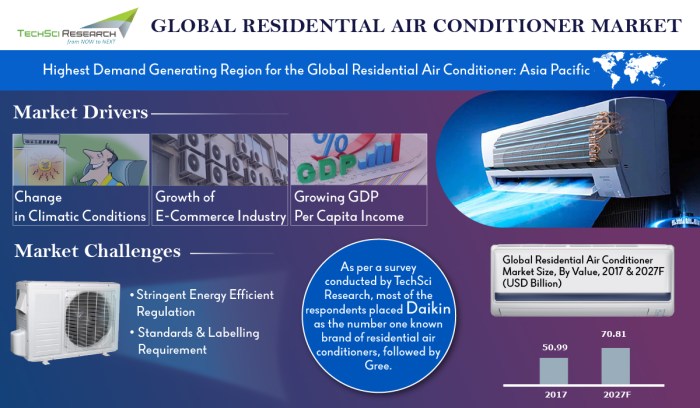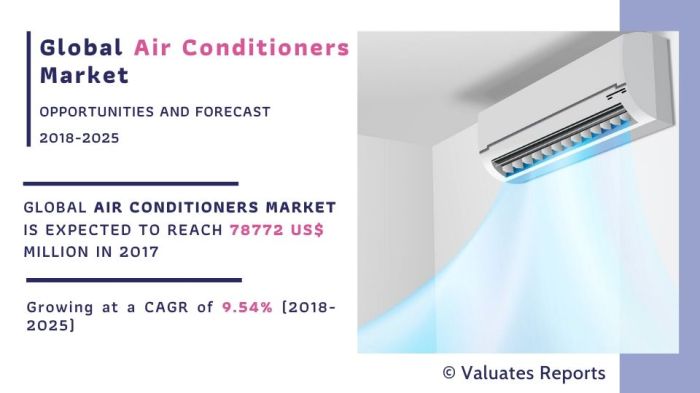Exploring the Latest Global Air Conditioner Market Trends to Watch
Global Air Conditioner Market Trends to Watch sets the stage for this enthralling narrative, offering readers a glimpse into a story that is rich in detail and brimming with originality from the outset. As we delve into the dynamic world of air conditioning, we uncover key insights and emerging trends that are shaping the industry landscape.
From technological advancements to shifting consumer preferences, this exploration promises to be a captivating journey through the ever-evolving realm of air conditioners.
Overview of Global Air Conditioner Market
The global air conditioner market is currently experiencing significant growth, with a steady increase in market size over the past few years. The market is projected to continue expanding at a rapid pace due to various factors influencing its growth.
Market Size and Growth Rate
- The global air conditioner market was valued at $104.4 billion in 2020 and is expected to reach $157.6 billion by 2026, with a CAGR of 7.2% during the forecast period.
Key Drivers Influencing Market Growth
- Rising demand for energy-efficient air conditioning systems to reduce electricity consumption.
- Increasing urbanization and industrialization leading to a higher demand for cooling solutions.
- Technological advancements in air conditioning systems, such as smart and connected devices.
Major Players and Market Share
- The major players dominating the global air conditioner market include Daikin Industries, Gree Electric Appliances, Mitsubishi Electric Corporation, LG Electronics, and Carrier Corporation.
- These companies hold a significant market share collectively, with Daikin Industries leading the market with a share of around 20%.
Regional Market Trends
- Asia Pacific region accounts for the largest market share due to high demand from countries like China and India.
- North America and Europe are also significant markets for air conditioners, driven by technological advancements and increasing awareness about energy efficiency.
Technological Advancements in Air Conditioners
Air conditioning systems have undergone significant technological advancements in recent years, revolutionizing the way we cool our indoor spaces. The integration of smart technologies like IoT (Internet of Things) and AI (Artificial Intelligence) has played a crucial role in transforming the air conditioner market, offering enhanced convenience, efficiency, and control to users.
Energy-Efficient Features in Modern Air Conditioners
- Variable-speed compressors: These compressors adjust their speed based on cooling demand, reducing energy consumption.
- Programmable thermostats: Allow users to set schedules for temperature adjustments, optimizing energy usage.
- Energy-efficient refrigerants: New refrigerants with lower global warming potential are being used to minimize environmental impact.
Impact of Green Technologies on the Air Conditioner Industry
- Solar-powered air conditioners: Utilize solar energy to power the cooling process, reducing reliance on traditional electricity sources.
- Heat pump systems: Offer both heating and cooling functions, maximizing energy efficiency by transferring heat rather than generating it.
- Smart sensors and automation: Enable precise temperature control and energy management, ensuring optimal comfort with minimal energy wastage.
Market Segmentation and Consumer Preferences
In the air conditioner market, understanding market segmentation and consumer preferences is crucial for manufacturers to meet the demands of various customer segments.
Types of Air Conditioners
- Split Air Conditioners: Split ACs are popular for their quiet operation and efficient cooling. They are commonly used in both residential and commercial settings.
- Window Air Conditioners: Window ACs are affordable and easy to install, making them a common choice for residential spaces.
- Portable Air Conditioners: Portable ACs offer flexibility and mobility, ideal for cooling specific areas without the need for installation.
Consumer Preferences
- Energy Efficiency: Consumers are increasingly prioritizing energy-efficient air conditioners to reduce electricity bills and minimize environmental impact.
- Cooling Capacity: Depending on the room size and climate conditions, consumers look for air conditioners with appropriate cooling capacity to ensure optimal performance.
- Design: The aesthetics of air conditioners play a significant role in consumer preferences, with sleek and modern designs gaining popularity in the market.
Demand by Sector
- Residential Air Conditioners: The residential sector accounts for a significant portion of air conditioner sales, driven by the need for comfort and temperature control in homes.
- Commercial Air Conditioners: Commercial spaces such as offices, retail stores, and hotels require air conditioning systems to maintain a comfortable environment for employees and customers.
- Industrial Air Conditioners: Industries rely on air conditioning systems to regulate temperatures in manufacturing facilities, warehouses, and other industrial settings.
Emerging Trends
- Smart Technology Integration: Consumers are increasingly drawn to air conditioners with smart features such as Wi-Fi connectivity, app control, and voice commands for enhanced convenience.
- Eco-Friendly Refrigerants: The shift towards eco-friendly refrigerants like R-32 and R-410A reflects consumer preferences for sustainable cooling solutions with reduced environmental impact.
- Multifunctional Units: Air conditioners that offer additional functions such as heating, dehumidification, and air purification are gaining popularity among consumers looking for versatile cooling solutions.
Environmental Regulations and Sustainability

Environmental regulations play a crucial role in shaping the global air conditioner market, as governments worldwide are increasingly emphasizing sustainability and energy efficiency. This has led to a notable shift towards eco-friendly practices and materials within the industry.
Shift Towards Eco-Friendly Refrigerants
The air conditioning sector has been transitioning towards eco-friendly refrigerants to comply with stringent environmental regulations. Traditional refrigerants such as R-22 have been phased out due to their harmful impact on the ozone layer and contribution to global warming. Companies are now focusing on using alternative refrigerants like R-410A, R-32, and hydrocarbons that have lower global warming potential and are more environmentally friendly.
Impact of Sustainability Trends
Sustainability trends have influenced the design and manufacturing of air conditioners, prompting companies to develop energy-efficient models with reduced carbon footprints. This has led to the adoption of innovative technologies such as inverter compressors, smart thermostats, and variable-speed motors, which optimize energy consumption and minimize environmental impact.
Additionally, manufacturers are increasingly using recyclable materials and implementing green practices in their production processes to enhance sustainability.
Companies Embracing Sustainability
Major players in the air conditioner industry are actively embracing sustainable practices to align with environmental regulations and consumer preferences. Companies like Daikin, Mitsubishi Electric, and LG Electronics have committed to reducing their carbon emissions, increasing energy efficiency, and promoting eco-friendly products.
For instance, Daikin has introduced air conditioners with refrigerants like R-32, which have a lower environmental impact compared to traditional alternatives. These initiatives not only benefit the environment but also enhance the brand image and competitiveness of these companies in the market.
Wrap-Up

In conclusion, the Global Air Conditioner Market Trends to Watch not only provide a snapshot of the current market scenario but also offer a glimpse into the future of air conditioning technology and consumer preferences. Stay tuned for more exciting developments in this fast-paced industry.
User Queries
What are the major drivers influencing the growth of the global air conditioner market?
The major drivers include rising temperatures, increasing disposable income, and technological advancements.
How are smart technologies like IoT and AI transforming the air conditioner market?
Smart technologies are enabling remote monitoring, energy efficiency optimization, and personalized comfort settings in air conditioning systems.
What are some examples of energy-efficient features in modern air conditioners?
Examples include inverter technology, programmable thermostats, and eco-friendly refrigerants.
How are environmental regulations impacting the global air conditioner market?
Environmental regulations are driving the shift towards eco-friendly refrigerants and sustainable practices in air conditioning systems.